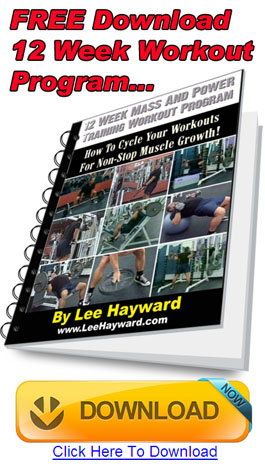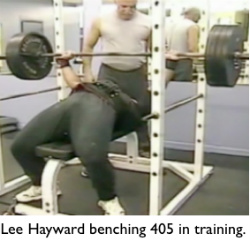These days it seems that everything needs to be bigger, faster, and stronger. Going to the extreme is the norm. Everything from extra strength headache pills, to energy drinks, and high speed Internet. Bottom line is that people want change and they want it now!
When it comes to bodybuilding things are no different we want results ASAP. The desire to build a better body unites all bodybuilding and fitness enthusiasts, but for most of us, the muscle gains come too slow and they never come easy. So we look for shortcuts. Is the secret to fast muscle gains training harder, lifting heavier, eating more, popping this pill, or slugging back the latest hyped up magic muscle drink…
In this article we are going to dive into 5 of the most common workout “shortcuts” that people take and pick them apart to find a better plan of action. More often then not the best methods for building a stronger and more muscular physique involve a less extreme approach.
Shortcut # 1 – Training More Often
A lot of times aspiring bodybuilders think they are not training enough and fall into the more is better mentality. After all more workouts must mean more muscle, Right?
It is not uncommon to find less experienced (but over enthusiastic) bodybuilders to start spending more and more time in the gym. Daily workouts become the norm and the length of those workouts gradually gets longer and longer. They usually think they are doing themselves good, and sometimes even brag about how they workout “everyday”.
Is there a better way?
Your body can only recover and grow so fast. Training a muscle again before you have fully recovered from your previous workout will eventually lead to overtraining. Generally the most you can train a bodypart is twice per week and still recover and grow.
While there are some exceptions to this rule with some abbreviated specialization routines (i.e. the Blast Your Bench program). You should limit yourself to working each bodypart no more then twice per week and taking at least 2 days per week off from weight training entirely as this is a good general guideline to follow for optimal muscle gains.
Shortcut # 2 – Doing More Sets
Making the transition from a beginner, to intermediate, to an advanced lifter usually involves increasing your workout training volume to some extent. The better shape you are in physically, the higher your work capacity, and the more volume of training you can handle.
For example, a beginner workout may consist of 6 sets per bodypart (i.e. 3 sets of 2 exercises). An intermediate workout may consist of 9 sets per bodypart (i.e. 3 sets of 3 exercises). And an advanced workout may consist of 12 sets per bodypart (i.e. 3 sets of 4 exercises). While this is all good general training advice, it breeds the “more is better” mentality. After all no one wants to be a newbie for long so they jack up the training volume too much, too soon.
Another problem with this train of thought is that if 12 sets per bodypart are good for an advanced lifter, will more sets be even better? How about 15 sets, or 20 sets, and beyond… Will this make me an “extremely advanced lifter”…?
Is there a better way?
Generally it takes at least 3 years of training to progress from the beginner, to the intermediate, and on to the advanced levels of training. Once you reach the advanced levels adding more sets and training volume beyond this is often counterproductive.
While there is no hard set rules for exactly how much training volume you should do, there are some general guidelines that you can follow. 9 sets per workout should be adequate for smaller muscle groups like biceps, triceps, calfs, and abs. And around 12 sets per workout will be enough for larger muscle groups like chest, back, and thighs.
Once you are at the advanced training level the key to more muscle growth is using progressive overload (gradually increasing your weights over time) and by adding variety to your workouts, by changing your exercises. NOT from adding more training volume.
Shortcut # 3 – Training Less Often
The world of bodybuilding is full of extremes, for a lot of guys it is either all or none… there is no middle ground. So after learning about the negative impacts of training too often, as outlined above, many bodybuilders make a complete U-turn and go the opposite direction and drastically cut back on their workouts figuring that “less is more”.
Some experts have gone over the deep end with the fear of overtraining. Mike Mentzer and his Heavy Duty style workouts were one of the biggest influences of the “less is more” idea. Overall the basic principles of this workout were good because it implemented a solid plan of action, used progressive overload, monitored your progress, etc.
But one major flaw of the system was that if you weren’t making progress with your workouts it was automatically assumed that you were “overtraining”, so your workouts were cut back. Sometimes going to the point of working out once a week or less. In fact there is one popular fitness guru who actually preaches that you only need to workout once every 4 weeks…?!?
Is there a better way?
For some extremely hardgainers training less often (i.e. every second day) may be the best frequency for muscle gains. But most people will respond well to more frequent workouts (i.e. 2 days on, 1 day off).
There are no hard set in stone rules that work for everyone, but a general guideline of working out 4-5 times per week and training each bodypart twice per week is a good place to start. As you get more experienced you be able to find out exactly what your body responds the best to and customize your workouts to fit your specific needs.
Shortcut # 4 – Heavy Weights & Low Reps
One of the basic bodybuilding principles is a bigger muscle is a stronger muscle. So in order to get bigger, you need to get stronger. Progressive overload is the cornerstone of all successful workouts. You need to gradually increase the weights you are lifting over time in order to make progress.
During the early phases of a starting a workout program beginners can make fast gains because all training stimulus is new at this stage. And a lot of the initial strength gains come not only from increasing muscle strength, but also from improved lifting technique and better coordination.
But once you get past the initial beginners phase, your strength gains come more slowly. When this happens a lot of lifters will simply do fewer reps so they can continue to increase the weights.
For example, if I can lift 100 lbs. for 10 reps, maybe I could drop the reps to 8 and lift 120 lbs., or drop the reps to 6 and lift 140 lbs., etc… While this may work to some degree initially to get you growing again, there comes a point where it can back fire and bring your gains to a screeching halt.
Is there a better way?
Lifting heavier weights for lower reps increases your odds of getting an injury such as a muscle tear. When you are doing fewer then 5 reps per set you lose the mind muscle connection. The lift becomes an end in itself and no longer a means for building muscle. Lifting too heavy makes it harder to concentrate on the muscles you are working, your focus switches to simply moving the weight and not getting crushed under a heavy barbell.
While you can successfully incorporate low rep training cycles into your workouts from time to time. They shouldn’t be your primary focus. For bodybuilding purposes try to stay within the 6-12 rep range. This is the “sweet spot” for keeping your muscles under tension long enough to stimulate growth, while still allowing relatively heavy weights to be lifted.
Shortcut # 5 – High Intensity Techniques
A lot of hardgainers think the key to making faster gains in the gym is to simply work harder. So they increase the intensity of their workouts with various advanced training techniques such as forced reps, super sets, drop sets, and so on… Thinking that the harder they push themselves, the better gains they’ll make. While these guys certainly deserve an A for effort, is pushing past the point of muscular failure really necessary?
Is there a better way?
One of my favorite training motto’s is “Stimulate, Don’t Annihilate!”
For the average drug free lifter using advanced training techniques and pushing yourself to the limit will quickly lead to burnout, overtraining, and possibly injury.
A very common mistake that you can witness pretty much any day of the week in the gym is to see a couple of eager young lifters doing bench presses with WAAAYYY too much weight on the bar. One guy will be getting ready to bench while his trusty spotter is standing by ready to assist the lift. After getting psyched up the lifter plops down on the bench and takes the bar from the rack, he manages to struggle up 2-3 reps using piss poor form and every ounce of effort his body can muster. Then he gets his spotter to assist him with an addition 3-5 reps.
At the end of the set you wonder who worked the hardest, the guy benching or his buddy pulling the bar off his chest…?
This is a prime example of abusing high intensity techniques. Once you reach failure with an exercise you have stimulated the muscle. Doing more then this is often not only waste of time, but could potentially set you back in your training through risk of injury.
I rarely, if ever, use any type of set extending high intensity techniques like forced reps in my training anymore. I’ve found that they are just not necessary. Doing your sets to positive failure is intense enough to stimulate your muscles to grow.
Once you reach failure, make note of it in your training journal and then strive to beat what you did for your next workout by either adding an additional 5 lbs. to the bar or doing an extra rep with the same weight. Using progressive overload like this will ensure that you constantly push yourself to make steady strength and muscle gains.
The Real Shortcut To Fast Muscle Growth
Gains in muscle and strength don’t come overnight. They take consistency over the long term. By taking things at a manageable pace and making small frequent improvements week after week with your workouts your muscle size will increase faster then you ever thought possible… without having to go to the extremes to get there.
Inch by inch life’s a cinch… Yard by yard life is hard…







47 Comments
Mike Westerdal
Love the new blog and makeover!
fitness course
Building muscles is not an easy task and the proper guidance is required to build muscles in right manner. This is possible only with the trained instructors. So always try to follow instructions of your instructor to maintain good body.
Mr I
Good information Lee as I go into week two of Critical bench 2.0 ! after filling out my first training log I can see where I will need to increase reps on some exercises and on others weight. It’s fascinating to learn how important patience and being consistent is in building strength.
Rajesh Sharma
” lifter plops down on the bench and takes the bar from the rack, he manages to struggle up 2-3 reps using piss poor form.Then he gets his spotter to assist him with an addition 3-5 reps.”
This is very common show off.
David Dee
What do you think of the classic 5X5 weight training routine?
Quincy Mitchell
I am 60 yrs old and thankfull for all your help. Q
Paul D.
Great info. Lee. Just what I needed. Almost answered all my questions. Please keep posting some routines. I’m still stuck @ this routine:
Mon (chest, shoulder, tri)
Wed (back, biceps)
Fri (Legs, abs)
Ian Smetona
I love the new blog Lee and the info you have been sharing. Also, thank you for addressing Mike Mentzer and his philosophy. I recently came across his material on the interwebs and was very curious about what others in the fieild thought about him.
Lee Clark
Nice stuff Lee, couldn’t agree more! The only time I lift below 5reps in a set is 3 days in the first week of my cycle to find my 1RM’s so that the excel formulas I created can automatically determine my workout weights for the next 8 weeks (with the 10th week as rest, then start week 1 again)
Your fellow PT,
Lee Clark
eddie
great stuff lee i am a new man with all the tips and how to the work outs on utube happy christmas
salmi
all what you said is right.thank you Lee for your advices.I think that young bodybuilders are really understanding what you mean.
Jim
Absolutely stunning!
This is probably one of the best monographs on working out I have ever read or heard and i”ve been close to bodybuilding since the 1950’s.
I’m now 78 and workout regularly using your overall workout which is also the best I’ve ever run across. Hanging around your website is NOT a waste of time. Thank you very much.
Jim
Mark
I see myself a few years ago in a few of those points. Bodybuilding/weight lifting definitely comes with a learning curve no matter how much one has read up on the subject in advance.
By the way, I think you meant to say, “Inch by inch, life’s a *cinch*”, not “synch”. At first, I was trying to figure out how my life would be more synchronized if I did things more gradually 🙂
zaker
hi lee,wondering can a 69 year old male still gain mussle mass?and if so what routine do you recomend.been working out all my life,in good shape,but maintaining same mass,
James
“When you are doing fewer then 5 reps per set you lose the mind muscle connection. The lift becomes an end in itself and no longer a means for building muscle.”
That’s good advice and not always obvious when you’re training.
sixtysomething
Articles like this are why you are my favorite muscle building coach.
Most others push folks toward negative results.
I used to do exactly what you warn against with minimal gain. At my age I would best call it maintenance. I took it down a notch and found new muscle growth.
You are spot on here!
Keep up the good advice, it is appreciated by all.
Thanks
Mike Rogers
Thanks Lee I listern and learn from what you keep telling us to do it makes sence to me I am 59 have been working out for 2 yrs and I see a big change in my body. Iam not soft any more I will stick with my work outs and will get stronger. Tks for your help and God bless Merry Christmas
.
Jackie
Thanks for the info. I also wonder the same thing because I noticed that lately my strength gains is in halt. As a woman, becoming big is out of the question & what I’m aiming for is muscle strength & to make my definition more visible. Right now I’m doing a body part split & both lasts for an hour. My typical schedule goes like this:
Tues & Sat – upper body & back
Thurs & Sun – lower body & abs
Jackie
By the way as with the amount of weights, as of now I lift 15-20 lbs. for upper body & 30-45 lbs. for lower body. I’m thinking of adding 5 lbs. during my squat session since I can still get away with 45 lbs. although I’ve been on that weight for only a week. I don’t know if its a good thing to increase weights in a short time.
leehayward
================
It’s a great strength program to follow. I have a 5×5 program posted on my blog at:
https://leehayward.com/blog/mass-and-power-workout/
leehayward
============
Typo fixed…
Thanks for the free editing services 🙂
leehayward
=================
Well obviously you are not going to make gains like someone who is younger. But regardless of age, improvement is always possible. My father is 60 years old and he hits the gym at least 3 days per week and is in much better shape then most men his age.
leehayward
============
A good piece of advice that I got from Vince Gironda ( http://www.VinceGirondaProgram.com ) is to keep the same weight for 3 workouts. After 3 workouts you should strive to increase the weights by 5 pounds. This is a safer and more manageable pace then trying to increase the weights you lift every single workout. You can make more consistent progress this way with less risk of injury.
Doug
60 where do I start ?
leehayward
Thanks for the comments folks, I’m glad to hear that you enjoy the tips and advice that I share here via my blog. It means a lot 🙂
Mohit
It is really Great Blog.
I am intermediate level love to do weight training but my problem is my tummy fat.
my height is 5’8″ and weight is 70 kilogram. how do i manage weight training with cardio……….
Suneet - SebastianFitnessSolutions.com
This is one of your best posts Lee
Particularly love the point you made about how people misuse these so-called “intensity techniques”
Thanks for another great post and great job with the new look of the blog. Looks killer 😉
Jerry
Excellent article, Lee.
I realize that it is dependent on many factors, but for an intermediate weightlifter, how often should a bodybuilder take a break from weightlifting? I have hear anywhere from three weeks to eight weeks on before taking a week off. Also, would you recommend some or absolutely no cardio on the off-week?
will haynie
I’m one.of your customer following a routine suggested in 1 of your email :1st day chest/bicep 2nd day: legs 3rd day: rest 4th day:shoulders/traps 5th day back/triceps and 6+7th day rest..my question is is it ok to do kettlebell routine between those days listed where I would have only 1day off a week
.please respond thx
Malik Asif
Excellent .I am really impressed by ur theory .
leehayward
========================
The real key to fat loss and getting a lean stomach is your diet…
Weight training and cardio are important as well. But without a proper diet you’ll never get that lean defined look that you are after. I cover how to go about dieting for fat loss in my Extreme Fat Loss Program at:
http://www.leehayward.com/dvd/xfatloss.htm
leehayward
=======================
Thanks, I’m really pleased with how the new blog layout looks.
leehayward
==========================
There is really no set answer to this. But my advice is if you are pushing your training really hard for any length of time (i.e. bodybuilding contest prep, training for sports, physique transformation contest, etc.) then after you are finished you could take a week off to give your mind and body a break.
Sometimes a change is as good as a rest as well. Just recently I spent 2 weeks in Mexico and never stepped foot inside gym, but I still kept active with bodyweight exercises, rubber fitness bands, and lots of walking, swimming, surfing, etc.
leehayward
=====================
If you want to add in kettle bell training you can probably add them in after your weight training workouts, or even devote 1 day per week to just kettle bell workouts. The main thing is to make sure to factor in enough recovery time so you don’t burn out from trying to do too much at once.
ruben
wow man right on good looking out brother man u really know ur stuff thans for info god bless.
John
your time-ly tips & sound advice are things i put into practice 3 days a week . thanks for them all.
James Mc Donagh
Hi Lee,
Thamk you so much for all your extensive workout programmes and muscle building information. Im now 28, and 6ft 4″. I always had a thin build while growing up but in the past few years I have been going to the gym. By using the techniques which you have shown me I have noticed a great improvement and change in my physique. This has even been commented on by my friends.
Thank you once again for all your help.
James
Ray
Lee,
After Reading Girdona’s thoughts on 60/80 instead of failure and doing my own research I totally agree with your stimulate motto.
That being said— I loved the pump I got from your extended set routine from the Fast Mass Program with Vince— Some of those sets that extended set, even at 50%, sometimes took that pump past the stimulate phase to the fatigue phase— Is there a cue, other than form change, to use to know when to put the extended set down? There are hard chargers like me out there that have a hard time with scratching a set…especially at 50%.
Looking forward to your advice
Ray
21 Day Fast Mass Building
I just wish that these shortcuts really work. I have tried a lot of fast muscle building program and none of them works. I can feel that this one is the right one for me.
TecKNOWLEDGEy
So True on these Lee. I’ve been working out very consistently for about 3 years, so I’ve tried a lot of different things by now. I’ve learned that making the mind-muscle connection is vitally important to lifting weights, but it takes time to really be able to focus on the muscle you are intending to stimulate. Progressive overload works when you can master the weight you are lifting and be able to fully contract the intended muscle. That ability definitely breaks down when you go too heavy and incorporate other muscle groups to just move the weight any way possible. When I dropped the amount of weight I was lifting, got my form and mind-muscle connection down (still have some trouble finding it with my pecs) and started “from scratch” on a progressive overload program, I made more gains in 2 months than in the previous year. I just got started on p90x2 as I’m a coach for beachbody, love their products, and love to switch my training up. But when that program is done I’m going to start from scratch again and progressively work my way up as I put your advice to work! Thanks Lee
Iron Head
What I see in gyms now….Youngsters on the bench with 225lbs on the bar lowering the bar half way or quarter of the way then pushing it up,getting off the bench with their chest puffed up saying they can bench 225!….This is also the same for squat and hacks! What are these wannabee’s reading or who is telling them this bad info? I see it all the time!
leehayward
I actually made a blog post about this at: https://leehayward.com/blog/bench-press-deadlift-duo
David ROCK Nelson
Lee- I read all your articles on Mass-gaining & I respect you as a fellow All-Natural bodybuilder. I’ve been using the advice you give on mass-gaining & the New Year’s “Pig-Out” Eating, etc. -& lastnight(Thurs. Jan. 6th, 2012) at 11:59 pm, when I worked-out in my room, as my fave nightly show “The UNTOUCHABLES”(starring the late Robert Stack as ELIOT NESS, my boyhood hero) was on “ME TV Network”, I did a set of leg-raises, 80 reps(lying on back on floor & raising legs up to celining) plus 3 intense sets of 15-20 reps “Bar Dips”, followed by a hard set of as many push-ups I could do, 32 reps! I was so tight & pumped, I ended my workout there, had my after-workout glass of milk(I usually have that 1% or 2% milk mixed with whey powder) & then a nice meal of ground beef, mashed potatoes. Later I had some more milk & a few cookies as I watched my fave late-nite show, “The OUTER Limits”(the 1963-65b series) on THIS station. When I weighed myself today I see that I “finally” gained some weight, I’m back up to 185! “Yay”! I feel bigger & stronger, too. Thanks for your advice. Many kids here(in Park Ridge, IL. near my town of Des Plaines, IL near O’Hare Airport) think I’m on steroids or say I’m “jacked” when they ask me to flex my muscles for them. I tell them: “NO! That’s from 40-plus years of working-out! I work-out hard, I EAT good & drink my milk. Sure, I have the occasional protein drink, I mix whey, which is natural in milk after a workout but mostl;y, I eat alot of protein(meat, tuna fish, eggs, milk), carbs from rice, potatoo, veggies & I snack on a small bag o’ peanuts between lunch & dinner”. They still falsely accuse & say I’m on steroids but I “Boldly” tell them: “I NEVER took nor ever want to take steroids! This is ALL-NATURAL muscle- & I’m ’55’! If you work out hard & eat good & drink you milk YOU CAN gain muscle! You DON’T need steroids, because your body ‘manufactures’ it’s OWN growth hormone! It is released during exercise & the food you eat ‘feeds’ the muscles,causing them to grow”! Keep up the good work, spreading the truth on Natural body-building! -Your “Fiend” ROCK! The guy who makes Fun “Monster” movies(I sell my movies on dvd). DAVID ROCK NELSON.
David
Interesting article which hopefully will help give me some direction in my training. I am 68 and have been training fairly consistently for the last 5 years and sporadically for 3\4 years previously. Most gains have been at the current gym, triggered by squats and dead lifts. Sadly I injured my back whilst squatting which put me out of the game for a year. Since then I’ve tried a number of training regimes which I follow fairly strictly, recording progress and using past achievements as a motivator. My current schedule focuses on one body part per day based on 4 days per week but I am getting stale and need a change. I am 5 foot 6 inches tall and weigh in at 104 Kilos. My goal is to lose fatty weight whilst also increasing muscular size. I have been following a cardio\weight training regime lasting about one and half hours but its become clear that each body part session is to far apart. If I am to train each body part twice a week what do I leave out.
kevin redman
David,
Hi just had to thank you for a great report also liked some of the replies good to see some senior people taking there traing to the next leval
Malik
interesting n convincing…
Michael Hermann
This is an interesting and useful article..